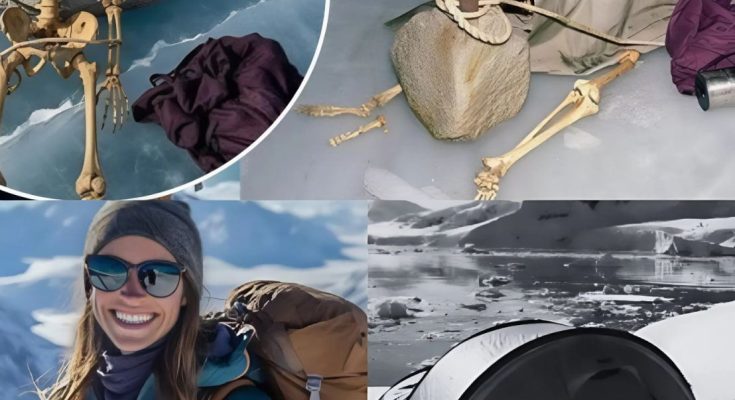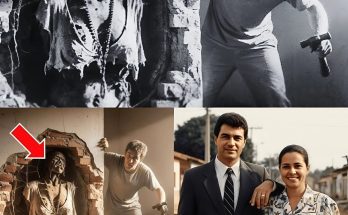Seven years. Seven long years had passed since Emily Harper disappeared without a trace into the vast, unforgiving wilderness of Alaska. For a small town like Talkeetna, a place where everyone knew each other, her disappearance was a wound that never fully healed. Volunteers combed the dense forests, helicopters swept over jagged mountain ridges, and search parties scoured frozen rivers, yet all efforts yielded nothing. Emily had simply vanished. Until one cold November morning, when the ice cracked like thunder, and her body surfaced—a haunting tableau that would stun even the most seasoned investigators.
What rescuers found beneath the frozen sheet of the river was both chilling and enigmatic. Harper’s feet were bound with heavy stones, an intentional restraint that immediately ruled out accidental death. Yet, her face told a contradictory story—eerily serene, almost peaceful, as if she had chosen this icy grave herself. That first observation seemed to suggest resignation, a quiet surrender to the cold embrace of Alaska. But the scene held secrets that ran far deeper than despair or self-inflicted fate.

Next to her body lay a small, waterproof camera, preserved almost perfectly by the subzero temperatures. Investigators quickly retrieved it, initially expecting to find only mundane images of wilderness landscapes or remnants of her survival attempts. What they found instead turned the case into a surreal, almost otherworldly puzzle. The camera contained final images that no one could explain. Shadows flickered across the snow where no one should have been. Trees bent in unnatural ways. And in the last sequence of photographs, a figure—tall, indistinct, and impossibly still—watched from the tree line. Harper herself is visible in the frame, oblivious, seemingly unaware of the silent observer.
Veteran investigators, hardened by decades of exposure to crime scenes and tragedies, admitted being unsettled by the images. “We’ve seen suicides, accidental deaths, animal attacks,” said one detective who had spent years in Alaska, requesting anonymity. “But this… this doesn’t fit anything we’ve ever encountered. It’s like she was being stalked by something that shouldn’t exist in this world.”
The deeper forensic examination only amplified the mystery. Harper was an experienced outdoorswoman. She knew how to navigate Alaska’s treacherous terrain, how to build shelters, and how to survive the bitter cold. Her survival gear—thermal clothing, a compact tent, and basic supplies—should have allowed her to endure the wilderness for weeks, perhaps months. Yet she ended up beneath the ice within hours. There were no signs of struggle, no injuries other than those consistent with hypothermia, and nothing to suggest she had been dragged. The bindings on her feet, heavy stones affixed in a deliberate manner, implied intervention—either by herself under extraordinary circumstances, or by an unseen force.
Psychologists and criminal profilers have debated the possible explanations. Could this have been an act of voluntary isolation, a conscious decision to end her life in one of the most extreme ways imaginable? Harper’s serene expression might support this theory. Yet, the bindings challenge that narrative. Few people would voluntarily weigh themselves down with stones and enter a freezing river, especially a woman as experienced and resilient as Emily. The act seems ritualistic, deliberate, and terrifyingly unnatural.

Local folklore complicates the story further. Tales of the Nulah—malevolent spirits said to haunt Alaska’s forests and rivers—have circulated in Talkeetna for generations. According to legend, these spirits lure travelers to icy deaths, guiding them silently through snow-laden trees. Authorities dismiss these stories as superstition, yet the eeriness of Harper’s last known moments, coupled with the inexplicable shadows in the photographs, gives these legends a disquieting resonance. For some residents, Emily’s fate is proof that the wilderness still harbors mysteries beyond human comprehension.
The camera images themselves remain a forensic anomaly. Analysts noticed that timestamps were inconsistent with Harper’s documented movements. Certain frames captured objects in multiple locations simultaneously, an impossible phenomenon by conventional explanation. Some frames show shadows cast in directions inconsistent with the sun’s position, suggesting either technical malfunction or something more disturbing. Every time the images are studied, new questions arise, deepening the sense of unease surrounding the case.
Meanwhile, the coroner’s report adds further ambiguity. Emily’s body shows no defensive wounds, no injuries from wildlife, no signs of struggle. The hypothermia-induced death appears almost passive, yet the circumstances that led to it were active and deliberate. It is as though the forces that caused her death were unseen, guiding her toward her icy grave while allowing her final moments to be marked by an unnatural calm.
The social and psychological ripples of Harper’s death have been profound. Across online forums, amateur sleuths dissect every pixel of the camera footage, arguing over whether the figure in the tree line is human, supernatural, or some trick of light. Social media debates rage, yet the consensus remains elusive. The combination of Harper’s peaceful demeanor, the binding of her feet, and the ominous final photographs has created a narrative that is impossible to categorize. It challenges standard theories of survival, human psychology, and even the boundaries of natural law.

Emily Harper’s family has been caught in a liminal space between grief and terror. The discovery of her body brought closure to the uncertainty of seven years but also unleashed a wave of questions no one can answer. “We just want to know what happened to her,” said her sister, voice trembling. “But I don’t think anyone ever will.” Their pain is compounded by the fact that every conventional explanation—theories of suicide, foul play, or accidental death—falls short of capturing the full scope of the mystery.
This case, which began as a tragic missing-person report, has transformed into a haunting enigma that defies categorization. Was Emily Harper’s death a result of personal despair, a sinister human act, or something altogether beyond the natural world? The bindings on her feet, the shadows captured on her camera, and the figure lingering at the edge of the forest point toward a story that may never be fully understood. The Alaskan wilderness, beautiful and brutal, has once again proven that it does not yield its secrets easily.
As investigators continue to pore over evidence, one question looms larger than any other: what followed Emily Harper into the wilderness, and does it still linger in the cold forests and frozen rivers, waiting for the next unwary traveler? The ice that cracked like thunder did more than reveal a body—it revealed a story of mystery, fear, and the unnerving possibility that some forces, whether human, natural, or otherwise, are beyond comprehension.
Seven years of searching, speculating, and grieving may never lead to a definitive answer. Emily Harper’s final moments, immortalized in the frozen frames of her own camera, continue to haunt those who dare to look too closely. And as the wind whistles through Alaska’s barren forests, the story remains suspended in time—an icy riddle that challenges our understanding of mortality, isolation, and the thin line between reality and the unknowable.





